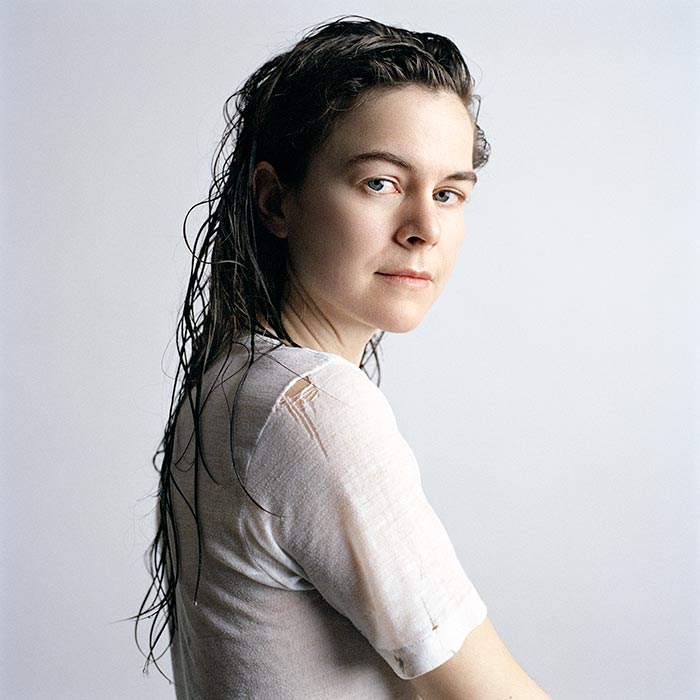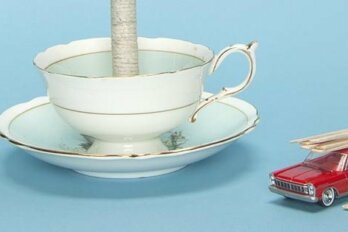
Shary Boyle is handling a porcelain statue she has just fired at 1,260°C, but her hands are steady, and she doesn’t break a sweat. She is equally unruffled when a technician walks into the studio with bad news: a kiln has short-circuited, and her previous day’s work may be lost. Her calm demeanour seems all the more remarkable because, as she tells me, “Porcelain is so fucking fragile, it gets everyone’s shoulders up. You’re constantly dealing with things blowing up into a million pieces.” Yet porcelain will be front and centre in her installation at the fifty-fifth Venice Biennale, which opens in June. It is the most ambitious work of her career, one that will be seen by more than 300,000 visitors over the course of its six-month run at the world’s oldest, most prestigious international art exhibition.
The influential English art critic Lawrence Alloway described the biennale as “the avant-garde in a goldfish bowl.” It is often called, more prosaically, the Olympics of the art world, because it brings together the most accomplished contemporary artists to display their talents in eighty-eight national pavilions. Athletes, however, have years to prepare, whereas most participants in the biennale have less than twelve months. It was only last summer that Marc Mayer, director of the National Gallery of Canada, called Boyle to say that a jury of experts had selected her as Canada’s sole representative. “We believed she could do something extraordinary,” he says. “And with very little time, she could knock it out of the park.”
For Boyle, the stakes could not be higher. Now forty-one, she has been a darling of the Canadian art scene for almost a decade, and the recipient of impressive national honours, including the 2009 Gershon Iskowitz Prize and the 2010 Hnatyshyn Foundation Award. By her own admission, however, she is an unknown abroad—something she hopes the biennale will rectify. “It’s frustrating when most responses to my art have come from my own country,” she says. “Having the same conversation with the same people is limiting—like never talking to anyone outside your family.”
Although her work resonates with Canadians, it is not rooted in Canadian themes. From the outset, her drawing, painting, sculpture, and performance have mined universal realities, such as death, aging, sexuality, pain, injustice, and grief, creating defiant narratives about marginalization and otherness. She will continue to follow this course in Venice, although whether her installation, a multimedia exhibition entitled Music for Silence, will click with international audiences remains to be seen. “There isn’t a formula for Venice,” says Mayer, “or every artist would use it every time. You can’t predict what will happen.”
Boyle feels equally tentative. “My work,” she says, “has always been a bit off-centre from the contemporary art world.” True. Her focus is deeply personal. While many artists follow theoretical, conceptually obtuse practices, she makes art that is highly literal and figurative. Moreover, for much of her career she has used traditional materials such as paint and porcelain rather than more trendy media like photography and video. In Venice, where collectors and curators hunt for the next big thing, her idiosyncratic vision and process might be an asset—or not.
It is like placing a piece of porcelain in a kiln. “You put all of your hope into it,” she says, “but in the end alchemy plays a big part.”
To understand Shary Boyle’s art means, in her own words, “getting into the psychology of Shary Boyle.” Art has always been a means for her to communicate, vent, and “deal with stuff that was really difficult, in a quiet and safe place,” she says. Grounded in an understanding of what happens “when you are different,” her creativity stretches back to 1984, when she was a grade seven student at a working-class, ethnically diverse junior high school in east Scarborough, Ontario; that year, as she puts it, “all the shit went down.” She was already prodigious, and when teachers put her art up for show some of her classmates felt compelled to deface it or rip it down. Daily physical assaults followed, and in an era before schools adopted zero tolerance policies on bullying, her teachers dealt with it by looking the other way. Her parents, whom she describes as “loyal, loving, but unpolitical,” and from a generation that did not question authority, did pretty much the same thing: “I was trapped in a situation where there wasn’t much to do except avoid, evade, and hide.”
In grade eight, she connected with a guidance counsellor who suggested she switch to Wexford Collegiate, a high school for the arts. There, she sang in a punk band (when I ask her its name, she laughs: “I can’t say. It’s too embarrassing”), which sparked a love for performance and heightened her interest in politics. “I was already sensitive to injustice,” she says. “Then that radical punk thing ripped me through its forces.” While still at Wexford, she won a sculpting award, another portent of things to come.
At seventeen, she was living in downtown Toronto and enrolled in a fine arts program at the Ontario College of Art (now OCAD University). Around this time, she began producing small stapled booklets of autobiographical drawings, which she would later reprint in her 2004 publication, Witness My Shame. These collections presented black and white depictions of vulnerability, rebellion, sexuality, and fantasy: a student vomits on her desk in front of her classmates; butterflies grow out of a prone female body; a young woman has sex with a grizzly bear; the artist’s death is mourned by her friends. They illustrated her unique talent for producing psychologically fraught images whose power lies in their ability to simultaneously seduce and repulse.
By the late ’90s, she was showing her work regularly in Toronto’s small Queen Street West galleries. Although still in her twenties, she was “beyond competent,” says Jessica Bradley, her current dealer and one of the country’s leading authorities on contemporary art. “Shary was saying the things we don’t dare talk about, addressing issues that others wouldn’t touch, but in a way that was totally frank and never sensational.”
As Boyle began to make her mark with visions of humanity in which even despair was rendered magical and beautiful, two other components of her practice came to the fore, each one startlingly original.
In 1999, the Toronto experimental filmmaker Kika Thorne cast her in Work, in which the artist’s hands were shot from above in acts of creation. Seeing the film served as a turning point for Boyle. “It captured the best part of drawing and painting,” she says, “something missing from the museum experience: the excitement and energy of making it.” Thorne introduced her to local musicians Leslie Feist and Merrill Nisker. The latter wrote the music for Work, and Boyle began performing with her as a backup singer. Then, inspired by Thorne’s film, the two created a “live drawing” show, in which Boyle composed images on sheets of acetate placed on an overhead projector, to the accompaniment of music. It was an enthralling new take on drawing, one that enlivened the medium with light and sound, and over the next decade she participated in similar concerts throughout Europe and North America, with such musicians as Jens Lekman in Sweden, Es in Finland, Will Oldham in California, Feist in Paris, Peaches in Berlin, and Christine Fellows in Canada.
As projected drawings became a part of Boyle’s practice, so did sculpture, the art form she had explored as a teenager. In 1998, grieving the death of a friend, she tried to paint a memorial portrait but found the two-dimensional form failing her. By chance, she tried making an elegy in Sculpey, a synthetic polymer clay; it was another revelation. “My three-dimensional mind took over,” she says. For several years, she worked with the medium privately, using it “like a diary” to make tiny, totemic figurines of often-erotic scenes. “You look at most art that deals with sexuality, and it’s male art about male lust,” she says. “My portrayal of sexuality is about my own experience, an authentic expression of something that needs to be put into the world in a shame-free, beautiful light.”
Four years later, en route to an artist’s residency in Yukon, she spent time in Seattle, where she met the ceramicist Charles Krafft, renowned for his sinister but amusing sculptures in the Delft tradition. When she told him she wanted to work with porcelain, for which she had no training, he connected her to doll maker Vivian Hausle, whose suburban ceramic studio attracted hobbyists from as far away as Korea and Japan. It was a subculture of mostly retired grandmothers, says Boyle: “I was by far the youngest piece of meat that ever walked in.” She enrolled in classes with the eighty-six-year-old Hausle, fascinated by her Royal Doulton–like figurines, and her flair for lace draping, a technique used to form delicate porcelain filigrees.
Boyle’s time with Hausle led to an awareness of the medium’s political relevance that fuelled her social consciousness. At its apogee in eighteenth-century Europe, the ruling classes used porcelain to signify prestige. This changed during the Industrial Revolution, when cheap, factory-made china figurines flooded the market. By the 1940s, lace draping had migrated to North America, where it became a staple of female doll makers and craft circles whose work was regarded as kitsch.
In Hausle’s basement studio, Boyle began to sample moulds for arms, legs, limbs, and bell-shaped skirts, but she combined and painted them in ways that subverted stereotypes and expressed her feminist viewpoint. “The politics of my family are so deeply chauvinistic,” she explains, “that it was natural, with my background and ideas about injustice, to become more aware of women’s roles and to become very rebellious.” When Hausle saw Boyle’s recalcitrant doll making—arms on backwards and sculpted vegetation growing from porcelain flesh—she was aghast. The art world saw things differently. In 2004, Reid Shier, the curator at Toronto’s Power Plant, one of the country’s leading public institutions devoted to contemporary art, visited Boyle’s Toronto studio. Just one glance at her porcelain statues convinced him that “she was poised to enter a new and bigger dialogue with the art world.”
Shier offered Boyle (still considered “a Queen West artist”) her first major exhibition. Called Lace Figures, it opened in 2006 and featured fifteen porcelain statuettes that explored feminine mythologies and hybridity. Smothered faces, limbs multiplied, insect and human forms combined in an array of physical forms—all demonstrated her desire to obscure the boundaries between species, genders, the inanimate and animate, life and death.
The show included Untitled (2005), in which a woman wearing a lacy black and mint green dress holds her decapitated head in her hands. Her face, tearful and delicate, contrasts starkly with the statue’s elegant but violent demeanour. Like every other work in the show, it was crafted with such refinement that critics remarked not only on Boyle’s imagination, but also on her technical virtuosity, which rivalled, they realized, that of such famed porcelain houses as Sèvres and Meissen. While the figurines made a searing commentary on female subjugation and pain, they were so compellingly beautiful that it was impossible to look away. Public institutions began snapping them up, and Boyle’s reputation as one of Canada’s most original artists was confirmed.
In 2007, Louise Déry, director at the Art Gallery of the University of Quebec in Montreal, seized upon another defining quality of Boyle’s practice: her ability to move from one medium to another. She organized Boyle’s first solo show, Flesh and Blood, which opened at the Art Gallery of Ontario in 2010 before travelling to Montreal and then Vancouver. For the first time, the exhibition brought together two unique features of her art, sculpture and projection, and gave her the opportunity to make works whose scale shifted from miniature to epic.
It included Virus (White Wedding), a life-sized kneeling female figure in all-white plaster. Her elongated hands held a fabric cobweb that flowed out from her mouth, navel, and groin. While the piece was provocative, its genius lay not in its form but in how, before viewers’ eyes, Boyle transformed it into something unexpected. Using an overhead projector that switched on and off, she streamed a wall-sized light drawing over the statue, temporarily revealing its surreal innards and simultaneously situating it in a rainbow vortex inhabited by bats, butterflies, creeping branches, and flowers. In this deft artistic play, she offered up a singularly original commentary on a question sculptors, including Michelangelo and Bernini, have been asking since antiquity: how does one bring the inanimate form to life?
Although she did not realize it at the time, through Virus and the 2010 exhibition she began to experiment with a dimension of her talent that will be on full display in Venice: the physical transformation of gallery space into an all-encompassing, otherworldly universe.
It is 8 o’clock on an evening in mid-March, and in a rare break Boyle is enjoying a glass of Cabernet Sauvignon on the sofa in her modest but charming Bloordale home, where the shelves and walls offer as much to take in as one of her installations. She has just shipped two containers to Venice, where she will begin installing Music for Silence in April. She is animated and excited about the prospect of spending two months in Italy, but when I ask how she thinks her work will be received she grows circumspect.
Every once in a while, she explains, her art makes people cringe, especially when, as with her installation in Venice, “it has to do with children or infants.” In Music for Silence, she will place what she describes as “a three-metre-long, 1,000-year-old plaster mermaid embracing a newborn.” As with Virus, she will project images onto it. When I ask why this might pose a problem, she counters loudly: “Come on! Who wants to deal with babies and art? It’s just not cool.” Furthermore, she adds, it will erroneously link the piece to what is now often seen as “embarrassing, out-of-date ’70s body art.” Still, the subject compels her as a feminist artist, because, she says, “Mother and child figures are so brutally overdone. They can only exist in the Catholic Church or in advertisements for soap. Artists today don’t know how to present family, childbirth, women and men. What do we do about this thing that is at the core of our life? ”
The mermaid will constitute just one aspect of her Venice installation, which deals with a subject far larger than maternalism. Boyle is creating a work that in its totality dares to reimagine the cosmos. To achieve this, she will completely overhaul the Canadian pavilion, physically immersing viewers in her vision of a new universe, an act of bravado that some art world onlookers speculate may play in her favour. Thousands of images per hour bombard visitors to the biennale. What Boyle has chosen to do, says Louise Déry, “is not just give them a painting or sculpture that they might casually walk by; she is presenting an all-consuming effect.” This approach references the exhibition’s most unforgettable installations of recent years, in which artists transformed their nation’s pavilions into unexpected utopias. Critical acclaim ensued when Hans Haacke uprooted and smashed the carefully laid marble floors of the German pavilion in 1993 (a reference to Hitler’s 1934 order that the parquet surface be replaced by marble slabs); when Chris Ofili turned the British pavilion into an “oasis of Africanness” in 2003; and when David Altmejd transformed the Canadian pavilion into a Wunderkammer in 2007.
In collaboration with a team of electrical, engineering, and architecture consultants, Boyle will build a curved wall within the Canadian pavilion to suggest the form of a shell. Its surface will be blackened and then covered with thousands of crystals arranged to represent the patterns of the galaxy. To absorb sound, the floor will be covered with a textured surface like volcanic ash. Near the entrance, three mountainous plinths will rise, each supporting a porcelain figurine bearing a ceramic planet. Two will sit atop slowly rotating vintage turntables, over which needles will hover but never touch the vinyl discs; casting beautiful, dramatic shadows, they will conjure a sound that isn’t there. Visitors will also encounter a 16-millimetre black and white film of a deaf female performer dressed in black except for her white face and hands. In sign language, she will articulate the artist’s dedication for the show and explain its message, “about silence, about communicating non-verbally,” says Boyle, “about words as a second language and images as a first.”
The subject—voice and its silencing—came to her as soon as she was invited to participate in the biennale, because she became acutely aware of “all the people who are not—and never will be—asked to take part in the exhibition: artists, writers, and musicians who are doing extraordinary things, but not in a popular way.” For them, she says, “I get to open the door.” The theme also references the artist’s personal history and helps to explain the presence of the larger-than-life mermaid, who will sit in a cave, surrounded by stalagmites and stalactites, as images from the natural as well as the silent world (Helen Keller, Charlie Chaplin) are projected upon her, transforming the pavilion into a theatrical space. Based loosely on Hans Christian Andersen’s Little Mermaid, who cuts out her tongue so she can live on land with her beloved, the fantastical creature is, in Boyle’s words, “the essential mute character,” an outsider, as she once was, now recast as a powerful, life-giving force.
For the pavilion’s exterior, she has created another defiant, mythical female: a bronze sentinel, part simian, part girl, who sits atop a column in front of the building holding the coloured ribbons of a maypole in her three hands. Visitors will see her from a distance, masked and crouching, her long hair flowing in the breeze, her eyes trained down on their comings and goings, beckoning them to peek inside Boyle’s world. Among them, she says, there may be “somebody from outside of Canada who has a different relationship to the kind of work I’m making.” For some artists, the biennale is a means of finding foreign galleries to sell their work and new collectors to buy it. Shary Boyle, however, has another goal. “I’m looking for someone out there who’s making work that responds to mine,” she says. “Maybe it will lead to a great show where I meet a bunch of people I’ve never talked to before. For me, that’s what it’s all about: who’s communicating, who’s listening.”
This appeared in the July/August 2013 issue.





